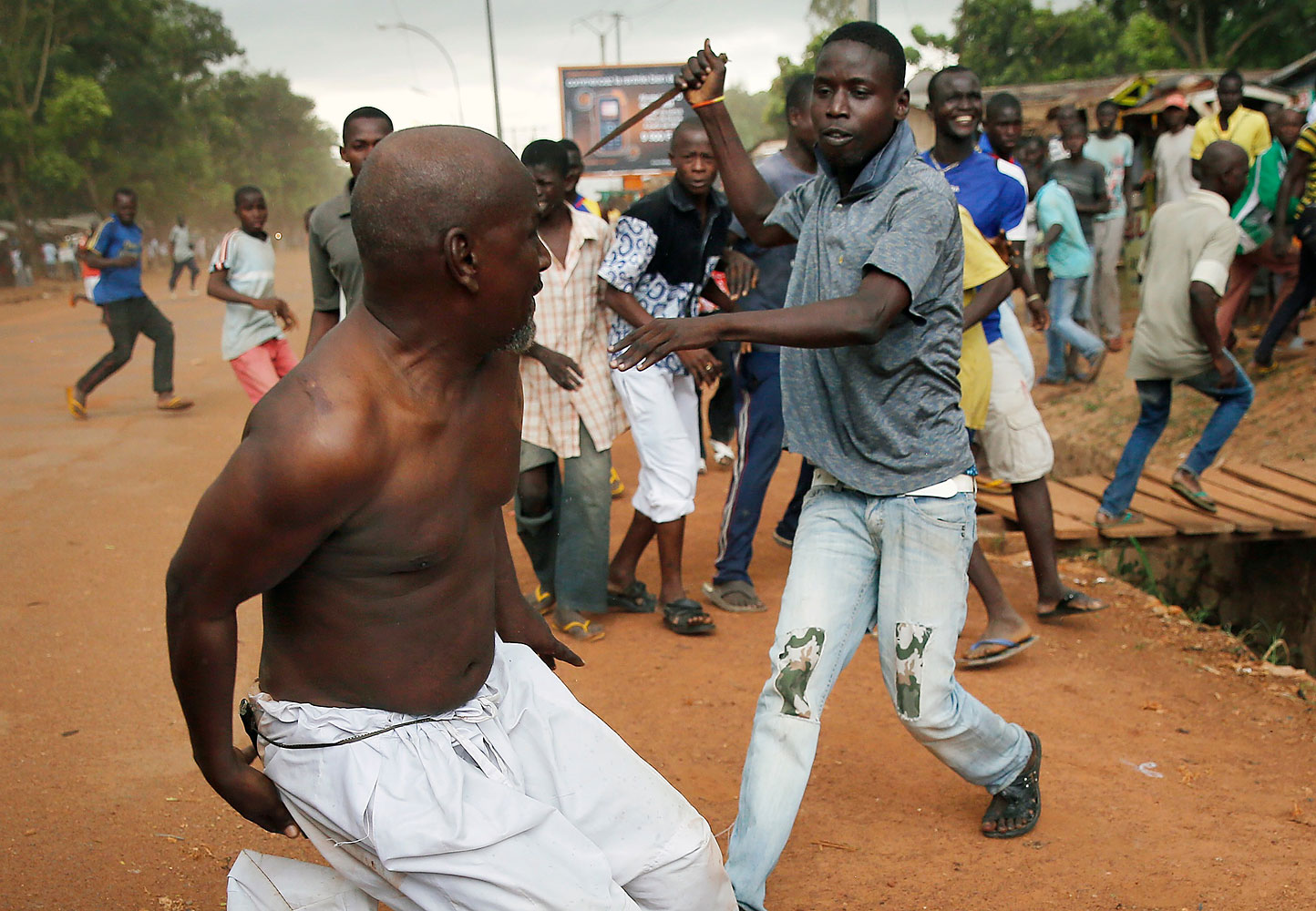
Features and Essays
Jerome Delay: Central African Crisis (NYT Lens blog) Includes interview with photographer. More of his work also on the Guardian website here
Marcus Bleasdale: Chaos in CAR (VII) The Central Africa Republic is aflame with violence as ethnic tensions between a primarily Christian population and the newly empowered Muslim Seleka Rebel group reach a boiling point
Pierre Terdjman: The Spiral of Violence (Paris Match L’Instant) Central African Republic
Robin Hammond: Condemned (Photographer’s YouTube) Audio slideshow on Hammond’s long term project documenting the treatment of mentally ill in Africa. Narration by the photographer himself.
Various photographers: Honoring Mandela (NYT) The New York Times’ coverage of Mandela’s death
Jonathan Torgovnik: South Africa’s Poor Tune In to Mandela’s Funeral (TIME) Watching Mandela’s funeral on television in Alexandra township, in Johannesburg
Kate Brooks: The View from Riyadh: Working Women (The New Yorker Photo Booth) Women in Saudi Arabia are making inroads into the country’s traditionally male-dominated workforce
Jonas Bendiksen: Far From Home (National Geographic) Millions of guest workers toil in oil-rich countries, cut off from both locals and loved ones
Lynsey Addario: In Lebanon, a Fear of Permanent Refugees (NYT) Lebanon worries that housing will make syrian refugees stay
Thomas Dworzak: Putin’s Party (National Geographic) Islamist insurgents, tough Cossacks, warm winters—welcome to Russia’s Olympic host city
Guillaume Herbaut: Ukraine Protests (Paris Match L’ Instant)
Adam Lach: The Roma in Poland (The New Yorker Photo Booth)
Magdalena Borowiec: In the shadow of Lenin Peak (Foto8) Mining in Kyrgyzstan
Francesco Zizola: Pope Francis (LightBox) Zizola photographed Pope Francis at the Vatican for TIME magazine’s annual Person of the Year issue
Enri Canaj: Family ties bind Albania’s social fabric (CNN Photo blog)
Sebastián Enriquez: Boxing for a Dream (New York Photo Booth) Peru
Vincent Rosenblatt: Favela Funk (NYT Lens blog) Brazil
Andrew Moore: This Is What It Looks Like at the Center of America (NYT Magazine) Moore has spent eight years photographing the area west of the 100th meridian, the territory formerly known as the Great American Desert, which remains one of the most sparsely populated regions in the country
Alec Soth: The Wandering Spirit (The New Yorker Photo Booth) Part of new long term project documenting America in collaboration with writer Brad Zellar

Todd Heisler: Once Around an Island (NYT) Twenty hours. More than 30 miles of coastline. Dozens of moments captured. The photographer Todd Heisler walked the perimeter of Manhattan over the course of one day in August
Todd Heisler: Gun Country (NYT) The United States continues to love and revile its hundreds of millions of firearms. Here is a look at that complicated relationship, told through the personal stories of Americans
Laura Morton: The Social Stage (Inge Morath Foundation) San Francisco’s high society
Katie Orlinsky: A Violent Border City’s Revival (NYT) Ciudad Juárez, city known for killing, gets back to living
Tomas Munita: Survivors of Bangladesh Disaster Receive Little Aid (NYT)
Eric Michael Johnson: Welcome to Tchotchke Town (NYT Magazine) World’s largest wholesale market for small goods in China
Articles

Syrian Photographer Molhem Barakat Killed in Aleppo (Reuters) Some of Barakat’s work on the Telegraph website here
Two Spanish journalists held by Al-Qaeda-linked group in Syria (Yahoo News) El Mundo newspaper correspondent Javier Espinosa and freelance photographer Ricardo Garcia Vilanova were seized in September. El Mundo said it had kept the kidnapping quiet until now while it contacted the captors via intermediaries
In Memoriam: Remembering the Photographers We Lost in 2013 (LightBox) As 2013 rolls to a close, LightBox pauses to remember the great photographers we lost this year
Obama’s Orwellian Image Control (NYT) AP’s Director of Photography Santiago Lyon writes about lack of access photojournalists have to President Obama
Why Photographers Need More Access In The White House (LightBox) Former White House photo editor Mike Davis on how the White House cutting out photographers hurts us all
White House criticized over press access (MSNBC) Charles Dharapak and Brooks Kraft explain why the limited access of White House photographers matters
White House Press Secretary to Photographers: We Respect You, But We Don’t Need You (PDN Pulse)
As Press Battles White House Over Photo Access, Did Media Cross its Own Line Publishing Obama/Bush Mandela Trip Pictures? (BagNewsNotes)
Staging Politics: Beyond White House Access, the Photo Op is the Larger Issue (David-Campbell.org) If media organizations want to give us open journalism that pulls back the curtain on the theatre of politics, they have to use this moment to question the centrality of the photo op in the presentation of politics
In Ford’s White House, Not Holding Back (NYT Lens blog) David Hume Kennerly on his time as President Ford’s White House photographer
Pictures That Change History: Why the World Needs Photojournalists (The Atlantic) It’s never been easier to take photos—or harder to capture ones that matter
The death of photography: are camera phones destroying an artform? (Guardian) From presidential selfies to never-ending Instagram feeds, the world is now drowning in images. Celebrated photographers debate the impact of this mass democratisation on their craft
AP’s Top 10 Photos of 2013 (AP Big Story) Selection by AP’s Director of Photography Santiago Lyon
Photography books of the year – review (Guardian)
The Top 10 Photo Books of 2013 (NYT Magazine blog)
Photo Books From 2013 You May Have Missed (Slate Behold)
Photo Projects That Made For A Better 2013 (PhotoShelter blog)
List of 2013 best of lists (Monroe Gallery blog)

Best of Getty Images 2013 (Denver Post)
Tearing Down the Pop Edifice of Mexico’s Drug Culture (NYT Lens blog) Shaul Schwarz on his Narco Cultura film
Susan Meiselas 1976-77 series on Bowery Santas (NYT Lens blog)
The Godfather of Street Photography (Dazed and Confused) King of the streets and master of cinema, New York-born, Paris-based William Klein is still going strong
The Letters of Sergio Larrain (Little Brown Mushroom blog)
Brent Stirton: A Native Son’s Ode To Nelson Mandela (PROOF)
Documenting South Africa’s Farewell to Nelson Mandela with Daniel Berehulak (Instagram blog)
João Silva Photographing Outside Apartheid’s White Bubble (NYT Lens blog)
In the Central African Republic, fear looks like a machete (AFP Correspondent blog) Photographer Fred Dufour on working in the Central African Republic
We Know Africa Is Not a Single Country, Newsweek Says (PDN Pulse) Newsweek.com published a story about the increasing dangers that gays face in Ethiopia. The only problem: The story is illustrated with photos taken not in Ethiopia, but in Uganda.
Robert Capa in colour sheds new light on a black and white master (Guardian) One of the 20th century’s most famous photojournalists, Robert Capa is renowned for his stark images of human conflict – but a New York exhibition of unseen colour shots could change all that
Open-Access Learning, Afghanistan Style (AFP Correspondent blog) AFP photographer Noorullah Shirzada on his widely seen Afghanistan picture
Robert Nickelsberg’s Photos Show the Suffering and Turmoil of War in Afghanistan (Daily Beast)
Three Photographers Reflect on Typhoon Haiyan (NYT) Photographers Bryan Denton, Sergey Ponomarev, and Jes Aznar covered the Typhoon Hayian aftermath on assignment for the New York Times
Kevin Frayer Instagramming Typhoon Haiyan (Newsweek)
Iraq war eyewitnesses: The stories behind the images (LA Times) Several Los Angeles Times photojournalists were among those who risked their lives to chronicle the war in Iraq
The Wider Image (Reuters) Reuters’ Wider Image app is now available also online
Olivier Jobard awarded Tim Hetherington Grant for 2013 (Canon Professional Network)
Behind the Cover: Martin Schoeller Photographs an Amazon Tribe (National Geographic) A young Kayapo girl represents her tribe on National Geographic magazine’s January cover
Photographer Teru Kuwayama Goes to Work at Facebook as Photo Community Liaison (PDN Pulse)
Photographers Richard Mosse and Zanele Muholi Named Top “Global Thinkers” by Foreign Policy (PDN Pulse)
Featured photographer: Michele Palazzi (Verve Photo)
Featured photographer: Marco Kesseler (Verve Photo)
Featured photographer: Patrick Brown (Verve Photo)
Interviews and Talks
Jason Andrew (Leica blog) On his project entitled “Black Diamonds” on young Nigerian footballers who were lured to Turkey with false promises of stardom
Brent Stirton (PROOF) Photography as obsession
Robert Schmidt (Onthemedia.org) The AFP photographer behind the ‘selfie-gate’ at Mandela memorial
Robert Nickelsberg (PROOF)
Marcus Bleasdale (National Geographic Live! on Youtube) Bleasdale wants to make people angry; as angry as he is about Africa’s first world war and the surprising way in which we are funding this violence
Ron Haviv (Anastasia Photo) Sebastian Junger interviews Haviv
Jodi Cobb (PROOF) On cultural exploration
Ivor Prickett (Panos Social) On his work in Iraqi Kurdistan
Eivind H. Natvig’s artifacts (PROOF) Artifacts is a series about physical items that have meaning to photographers in the field
Ben Lowy (NPPA) Embracing change
Mikko Takkunen is an associate photo editor at TIME.com. Follow him on Twitter @photojournalism.
More Must-Reads From TIME
- What Student Photojournalists Saw at the Campus Protests
- How Far Trump Would Go
- Why Maternity Care Is Underpaid
- Saving Seconds Is Better Than Hours
- Welcome to the Golden Age of Ryan Gosling
- Scientists Are Finding Out Just How Toxic Your Stuff Is
- The 100 Most Influential People of 2024
- Want Weekly Recs on What to Watch, Read, and More? Sign Up for Worth Your Time
Contact us at letters@time.com